3 Configuring Your B2B Domain
This chapter describes how to create and configure your B2B domain.
Before you begin the configuration process, ensure that you have completed installing the Oracle B2B software in the same Oracle home as Oracle Fusion Middleware Infrastructure and Oracle SOA Suite. For more information, see Chapter 2.
By the end of this chapter, you would have created database schemas for Oracle B2B and configured an Oracle WebLogic domain for B2B with one cluster and two managed servers on a single host.
This chapter contains the following sections:
3.1 Creating the Database Schemas
Before you can configure a B2B domain, you must install the required schemas on a certified database for use with this release of Oracle Fusion Middleware.
Follow the instructions in this section to install the schemas.
-
Section 3.1.1, "Installing and Configuring a Certified Database"
-
Section 3.1.2, "Starting the Repository Creation Utility (RCU)"
-
Section 3.1.3, "Navigating the RCU Screens to Create the Schemas"
3.1.1 Installing and Configuring a Certified Database
Ensure that you have installed and configured a certified database, and that the database is up and running.
For more information, see "Installing a Database and Database Schemas" in Planning an Installation of Oracle Fusion Middleware.
3.1.2 Starting the Repository Creation Utility (RCU)
To start the Repository Creation Utility (RCU):
-
Navigate to the
ORACLE_HOME/oracle_common/bindirectory on your system. -
Make sure that the
JAVA_HOMEenvironment variable is set to the location of a certified JDK on your system. The location should be up to, but not including thebindirectory. For example, if your JDK is located in/home/Oracle/JDK/jdk7_15/jdk1.7.0_15:On UNIX operating systems:
setenv JAVA_HOME /home/Oracle/JDK/jdk7_15/jdk1.7.0_15
On Windows operating systems:
set JAVA_HOME=C:\home\Oracle\JDK\jdk7_15\jdk1.7.0_15
Ensure that you replace the JDK location in these examples with the actual JDK location on your system.
-
Start RCU:
On UNIX operating systems:
./rcu
On Microsoft Windows operating systems:
rcu.bat
3.1.3 Navigating the RCU Screens to Create the Schemas
Schema creation involves the following tasks:
- Task 1 Introducing RCU
-
This is the Welcome screen. Click Next.
- Task 2 Selecting a Method of Schema Creation
-
If you have the necessary permission and privileges to perform DBA activities on your database, select System Load and Product Load. This procedure assumes that you have the necessary privileges.
If you do not have the necessary permission or privileges to perform DBA activities in the database, you must select Prepare Scripts for System Load on this screen. This option will generate an SQL script, which can be provided to your database administrator. For more information, see "Understanding System Load and Product Load" in Creating Schemas with the Repository Creation Utility.
- Task 3 Providing Database Connection Details
-
Provide the database connection details for RCU to connect to your database. You must provide the following information:
-
Database Type
-
Host Name
-
Port
-
Service Name
-
Username
-
Password
-
Role
Specify all of these information and click Next to proceed, then click OK on the dialog window confirming that connection to the database was successful.
-
- Task 4 Specifying a Custom Prefix and Selecting Schemas
-
Select Create new prefix, specify a custom prefix, and then select the SOA Suite schema. This will automatically select SOA Infrastructure, along with the following schemas as dependencies:
-
Metadata Services
-
Audit Services
-
Audit Services Append
-
Audit Services Viewer
-
Oracle Platform Security Services
-
User Messaging Service
-
WebLogic Services
A schema called Common Infrastructure Services is also automatically created; this schema is grayed out and cannot be selected or deselected. This schema enables you to retrieve information from RCU during domain configuration. For more information, see "Understanding the Service Table Schema" in Creating Schemas with the Repository Creation Utility.
The custom prefix is used to logically group these schemas together for use in this domain only; you must create a unique set of schemas for each domain as schema sharing across domains is not supported.
Tip:
For more information about custom prefixes, see "Understanding Custom Prefixes" in Creating Schemas with the Repository Creation Utility.
For more information about how to organize your schemas in a multi-domain environment, see "Planning Your Schema Creation" in Creating Schemas with the Repository Creation Utility.
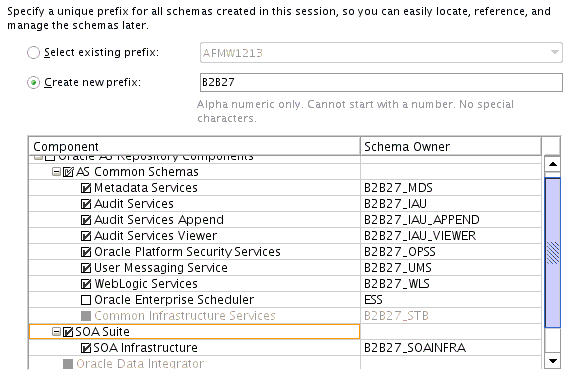
Description of the illustration rcu_select_schema.gif
Tip:
You must make a note of the custom prefix you choose to enter here; you will need this later on during the domain creation process.
Click Next to proceed, then click OK on the dialog window confirming that prerequisite checking for schema creation was successful.
-
- Task 5 Specifying Schema Passwords
-
Specify how you want to set the schema passwords on your database, then specify and confirm your passwords.
Tip:
You must make a note of the passwords you set on this screen; you will need them later on during the domain creation process.
- Task 6 Specifying Custom Variables
-
Ensure that you have reviewed the information provided in Section 1.9.
Specify the custom variables for the SOA Infrastructure schema. For the Oracle B2B standard installation topology, accept both default values for the Database Profile (SMALL) and Healthcare Integration (NO).
If you are configuring Healthcare, specify the Healthcare Integration value as YES.

Description of the illustration rcu_custom_variables.gif
Tip:
For information about the options on this screen, see "Custom Variables" in Creating Schemas with the Repository Creation Utility.
- Task 7 Completing Schema Creation
-
Navigate through the remainder of the RCU screens to complete schema creation. When you reach the Completion Summary screen, click Close to dismiss RCU.
3.2 Configuring Your B2B WebLogic Domain
This section provides instructions for creating a WebLogic domain using the configuration wizard. For more information on other methods available for domain creation, see "Additional Tools for Creating, Extending, and Managing WebLogic Domains" in Creating WebLogic Domains Using the Configuration Wizard.
Creating and configuring your domain includes the following:
3.2.1 Starting the Configuration Wizard
To begin the domain configuration, navigate to the ORACLE_HOME/oracle_common/common/bin directory and start the WebLogic Server Configuration Wizard.
On UNIX operating systems:
./config.sh
On Microsoft Windows operating systems:
config.cmd
3.2.2 Navigating the Configuration Wizard Screens to Create the Domain
Follow the instructions in this section to create and configure the domain for the topology.
Note:
You can use the same procedure described in this section to extend an existing domain. If your needs do not match the instructions given in the procedure, be sure to make your selections accordingly, or refer to the supporting documentation for additional details.
Domain creation and configuration includes the following tasks:
-
Task 1, "Selecting the Domain Type and Domain Home Location"
-
Task 10, "Configuring the Administration Server Listen Address"
-
Task 18, "Reviewing Your Configuration Specifications and Configuring the Domain"
-
Task 19, "Writing Down Your Domain Home and Administration Server URL"
- Task 1 Selecting the Domain Type and Domain Home Location
-
On the Configuration Type screen, select Create a new domain.
In the Domain Location field, specify your Domain home directory.
It is recommended that you locate your Domain home in accordance with the directory structure summarized in "What are the Key Oracle Fusion Middleware Directories?" in Understanding Oracle Fusion Middleware, where the Domain home is located outside the Oracle home directory. This directory structure will help you avoid issues when you need to upgrade or reinstall your software.
Tip:
For more information about the other options on this screen, see "Configuration Type" in Creating WebLogic Domains Using the Configuration Wizard.
- Task 2 Selecting the Configuration Template
-
On the Templates screen, make sure Create Domain Using Product Templates is selected, then select the following templates:
-
Oracle B2B - 12.1.3.0 [soa]]
Selecting this template automatically selects the following as dependencies:
-
Oracle SOA Suite - 12.1.3.0 [soa]
-
Oracle Enterprise Manager - 12.1.3.0 [em]
-
Oracle WSM Policy Manager - 12.1.3.0 [oracle_common]
-
Oracle JRF - 12.1.3.0 [oracle_common]
-
WebLogic Coherence Cluster Extension - 12 1.3.0 [wlserver]
-
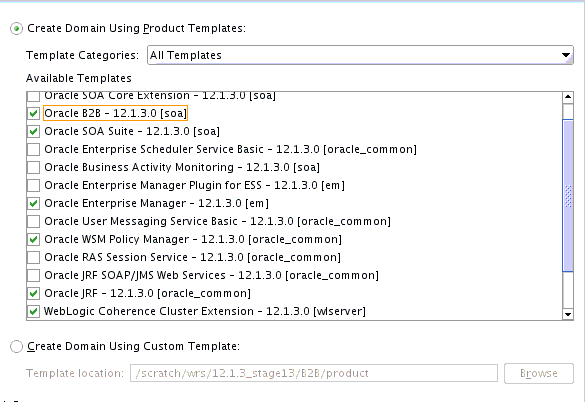
Description of the illustration config_b2b.png
Tip:
For more information about the options on this screen, see "Templates" in Creating WebLogic Domains Using the Configuration Wizard.
-
- Task 3 Selecting the Application Home Location
-
On the Application Location screen, select the location in which you want to store your applications associated with your domain. This location is also referred to as the Application home directory.
It is recommended that you locate your Application home in accordance with the directory structure summarized in "What are the Key Oracle Fusion Middleware Directories?" in Understanding Oracle Fusion Middleware, where the Application home is located outside the Oracle home directory. This directory structure will help you avoid issues when you need to upgrade or re-install your software.
Tip:
For more information about the Application home directory, see "Choosing an Application Home" in Planning an Installation of Oracle Fusion Middleware.
For more information about the options on this screen, see "Application Location" in Creating WebLogic Domains Using the Configuration Wizard.
- Task 4 Configuring the Administrator Account
-
On the Administrator Account screen, specify the user name and password for the default WebLogic Administrator account for the domain.
It is recommended that you make a note of the user name and password specified on this screen; you will need these credentials later to boot and connect to the domain's Administration Server.
- Task 5 Specifying the Domain Mode and JDK
-
On the Domain Mode and JDK screen:
-
Select Production in the Domain Mode field.
-
Select the Oracle HotSpot JDK in the JDK field.
Tip:
For more information about the options on this screen, see "Domain Mode and JDK" in Creating WebLogic Domains Using the Configuration Wizard.
-
- Task 6 Specifying the Datasource Configuration Type
-
Select RCU Data to activate the fields on this screen. The RCU Data option instructs the Configuration Wizard to connect to the database and Service Table (STB) schema to automatically retrieve schema information for the schemas needed to configure the domain.
Note:
If you choose to select Manual Configuration on this screen, you will have to manually fill in the parameters for your schema on the JDBC Component Schema screen.
After selecting RCU Data, fill in the following fields:
Field Description Vendor
From the drop-down list, select the your database vendor.
Driver
From the drop-down list, select the driver that you require.
DBMS/Service
Enter the database DBMS name, or service name if you selected a service type driver.
Host Name
Enter the name of the server hosting the database.
Port
Enter the port number on which the database listens.
Schema Owner
Schema Password
Enter the username and password for connecting to the database's Service Table schema. This is the schema username and password that was specified for the Service Table component on the "Schema Passwords" screen in RCU (see Task 5 in Section 3.1.3).
The default username is
prefix_STB, whereprefixis the custom prefix that you defined in RCU.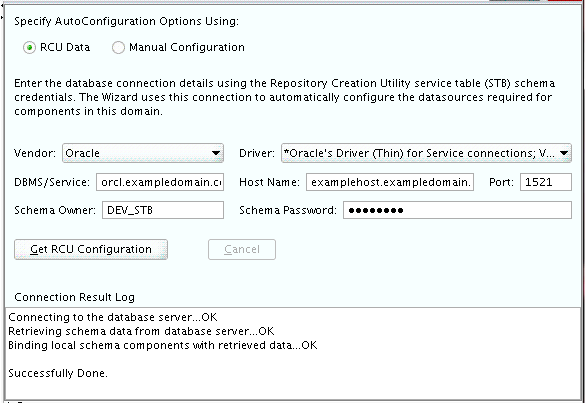
Description of the illustration config_datasource.gif
Click Get RCU Configuration when you finish specifying the database connection information. The following output in the Connection Result Log indicates that the operating succeeded:
Connecting to the database server...OK Retrieving schema data from database server...OK Binding local schema components with retrieved data...OK Successfully Done.
Tip:
For more information about the RCU Data option, see "Understanding the Service Table Schema" in Creating Schemas with the Repository Creation Utility.
For more information about the other options on this screen, see Datasource Defaults in Creating WebLogic Domains Using the Configuration Wizard
- Task 7 Specifying JDBC Component Schema Information
-
Verify that the values on the JDBC Component Schema screen are correct for all schemas. If you have selected RCU Data on the previous screen, the schema table should already be populated appropriately.
Tip:
For high availability environments, see the following sections in High Availability Guide for additional information on configuring data sources for Oracle RAC databases:
For more information about the other options on this screen, see "JDBC Component Schema" in Creating WebLogic Domains Using the Configuration Wizard.
- Task 8 Testing the JDBC Connections
-
Use the JDBC Component Schema Test screen to test the datasource connections you have just configured.
A green check mark in the Status column indicates a successful test. If you encounter any issues, see the error message in the Connection Result Log section of the screen, fix the problem, then try to test the connection again.
Tip:
For more information about the other options on this screen, see "Test Component Schema" in Creating WebLogic Domains Using the Configuration Wizard
- Task 9 Selecting Advanced Configuration
-
To complete the domain configuration for the topology, select the following options on the Advanced Configuration screen:
-
Administration Server
This is required to properly configure the listen address of the Administration Server.
-
Node Manager
This is required to configure Node Manager.
-
Managed Server, Clusters and Coherence
This is required to configure the B2B Managed Server.
-
- Task 10 Configuring the Administration Server Listen Address
-
On the Administration Server screen, select the drop-down list next to Listen Address and select the IP address on the host in which the Administration Server will reside.
Do not use All Local Addresses.
Do not specify any server groups for the Administration Server.
- Task 11 Configuring Node Manager
-
The Node Manager screen can be used to select the type of Node Manager you want to configure, along with the Node Manager credentials.
Select Per Domain Default Location as the Node Manager type, then specify the Node Manager credentials.
Tip:
For more information about the options on this screen, see "Node Manager" in Creating WebLogic Domains Using the Configuration Wizard.
For more information about the types of Node Manager, see "Node Manager Overview" in Administering Node Manager for Oracle WebLogic Server.
- Task 12 Configuring Managed Servers
-
On the Managed Servers screen, create a new Managed Server named
b2b_server1:-
In the Listen Address drop-down list, select the IP address of the host on which the Managed Server will reside or use the system name or DNS name that maps to a single IP address.
Do not use All Local Addresses.
-
In the Server Groups drop-down list, select SOA-MGD-SVRS. This server group ensures that SOA and Oracle Web Services Manager (OWSM) services are targeted to the Managed Servers that you are creating.
There is another server group called SOA-MGD-SVRS-ONLY that targets only SOA but not Oracle Web Services Manager (OWSM) to the server. This is typically used if you want to have Oracle Web Services Manager (OWSM) in a different server rather than with the SOA server.
Server groups target Fusion Middleware applications and services to one or more servers by mapping defined application service groups to each defined server group. A given application service group may be mapped to multiple server groups if needed. Any application services that are mapped to a given server group are automatically targeted to all servers that are assigned to that group. For more information, see "Application Service Groups, Server Groups, and Application Service Mappings" in Domain Template Reference.
-
Click Add and repeat this process to create a second Managed Server named
b2b_server2.Configuring a second Managed Server is one of the steps needed to configure the standard topology for high availability. If you are not creating a highly available environment, then this step is optional.
For more information about the high availability standard topology, see "Understanding the Fusion Middleware Standard HA Topology" in High Availability Guide.
For more information about the next steps to prepare for high availability after your domain is configured, see Section 5.3.
These server names and will be referenced throughout this document; if you choose different names, be sure to replace them as needed.
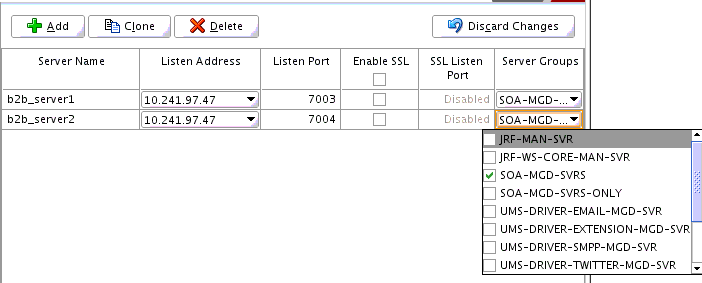
Description of the illustration b2b_server.png
Tip:
For more information about the options on this screen, see "Managed Servers" in Creating WebLogic Domains Using the Configuration Wizard.
-
- Task 13 Configuring a Cluster
-
Use the Clusters screen to create a new cluster:
-
Select Add.
-
Specify
b2b_cluster1in the Cluster Name field. -
Leave the Cluster Address field blank.

Description of the illustration b2b_cluster.png
New clusters can also be created by using the Oracle WebLogic Server Administration Console. In such cases, cluster communication (unicast or multicast) can be configured when the new cluster is created. For more information, see "Create and configure clusters" in Oracle WebLogic Server Administration Console Online Help
Tip:
For more information about the options on this screen, see "Clusters" in Creating WebLogic Domains Using the Configuration Wizard.
-
- Task 14 Assigning Managed Servers to the Cluster
-
Use the Assign Servers to Clusters screen to assign
b2b_server1andb2b_server2to the new clusterb2b_cluster1:-
In the Clusters pane, select the cluster to which you want to assign the servers; in this case,
b2b_cluster1. -
In the Servers pane, assign
b2b_server1tob2b_cluster1by doing one of the following:-
Click once on
b2b_server1to select it, then click on the right arrow to move it beneath the selected cluster (b2b_cluster1) in the Clusters pane. -
Double-click on
b2b_server1to move it beneath the selected cluster (b2b_cluster1) in the clusters pane.
-
-
Repeat to assign
b2b_server2tob2b_cluster1.

Description of the illustration b2b_cluster_server.png
Tip:
For more information about the options on this screen, see "Assign Servers to Clusters" in Creating WebLogic Domains Using the Configuration Wizard.
-
- Task 15 Configuring Coherence Clusters
-
Use the Coherence Clusters screen to configure the Coherence cluster that is automatically added to the domain. Leave the default port number 0 as the Coherence cluster listen port.
Note:
Setting the unicast listen port to 0 creates an offset for the Managed Server port numbers. The offset is 5000, meaning the maximum allowed value that can be assigned to a Managed Server port number is 60535, instead of 65535.
See Table 5-2 for more information and next steps for configuring Coherence.
Note:
For Coherence licensing information, see "Oracle Coherence" in Licensing Information.
- Task 16 Creating a New Machine
-
Use the Machines screen to create a new machine in the domain. A machine is required in order for the Node Manager to be able to start and stop the servers.
Tip:
If you plan to create a high availability environment and know the list of machines required for your target topology, you can follow the directions in this section to create all of the machines at this time. For more information, see "Optional Scale Out Procedure" in High Availability Guide.
-
Click Add to create a new machine.
-
Specify
b2b_machine1in the Name field. -
In the Node Manager Listen Address field, select the IP address of the machine where the Managed Servers are being configured.
You must select a specific interface and not "localhost." This allows Coherence cluster addresses to be dynamically calculated.
-
Verify the port in the Node Manager Listen Port field.
The port number
5556, shown in this example, may be referenced by other examples in the documentation. Replace this port number with your own port number as needed.
Note:
If you are extending an existing domain, you can assign servers to any existing machine. It is not necessary to create a new machine unless your situation requires it.

Description of the illustration b2b_machine.png
Tip:
For more information about the options on this screen, see "Machines" in Creating WebLogic Domains Using the Configuration Wizard.
-
- Task 17 Assigning Servers to Machines
-
Use the Assign Servers to Machines screen to assign the Administration Server and Managed Servers to the new machine you have just created:
-
In the Machines pane, select the machine to which you want to assign the servers; in this case,
b2b_machine1. -
In the Servers pane, assign
AdminServertob2b_machine1by doing one of the following:-
Click once on
AdminServerto select it, then click on the right arrow to move it beneath the selected machine (b2b_machine1) in the Machines pane. -
Double-click on
AdminServerto move it beneath the selected machine (b2b_machine1) in the Machines pane.
-
-
Repeat to assign both
b2b_server1andb2b_server2tob2b_machine1.

Description of the illustration b2b_machine_servers.png
Tip:
For more information about the options on this screen, see "Assign Servers to Machines" in Creating WebLogic Domains Using the Configuration Wizard.
-
- Task 18 Reviewing Your Configuration Specifications and Configuring the Domain
-
The Configuration Summary screen contains the detailed configuration information for the domain you are about to create. Review the details of each item on the screen and verify that the information is correct.
You can go back to any previous screen if you need to make any changes, either by using the Back button or by selecting the screen in the navigation pane.
Domain creation will not begin until you click Create.
Tip:
For more information about the options on this screen, see "Configuration Summary" in Creating WebLogic Domains Using the Configuration Wizard.
- Task 19 Writing Down Your Domain Home and Administration Server URL
-
The Configuration Success screen will show the following items about the domain you just configured:
-
Domain Location
-
Administration Server URL

Description of the illustration config_success.png
-
You must make a note of both items as you will need them later; the domain location is needed to access the scripts used to start the Node Manager and Administration Server, and the URL is needed to access the Administration Server.
Click Finish to dismiss the configuration wizard.
3.3 Starting the Servers
After the configuration is complete, do the following to access the tools with which you can manage your domain:
Note:
For more information on additional tools you can use to manage your domain, see "Overview of Oracle Fusion Middleware Administration Tools" in Administering Oracle Fusion Middleware.
3.3.1 Starting the Node Manager
To start your per-domain Node Manager, go to the DOMAIN_HOME/bin directory.
On UNIX operating systems, start the Node Manager as shown below, using nohup and nm.out as an example output file:
nohup ./startNodeManager.sh > $LOG_DIR/nm.out&
In the preceding command, LOG_DIR is the location of directory in which you want to store the log files.
On Windows operating systems, run:
startNodeManager.cmd
Note:
On Windows operating systems, it is recommended that you configure Node Manager to run as a startup service. This allows Node Manager to start up automatically each time the system is restarted.
For more information, see "Running Node Manager as a Startup Service" in Administering Node Manager for Oracle WebLogic Server.
For information about additional Node Manager configuration options, see Administering Node Manager for Oracle WebLogic Server.
3.3.2 Starting the Administration Server
To start the Administration Server, go the DOMAIN_HOME/bin directory.
On UNIX operating systems, run:
./startWebLogic.sh
On Windows operating systems, run:
startWebLogic.cmd
If you have selected Production Mode on the Domain Mode and JDK screen in Task 5 (Section 3.2.2), you will be prompted for the login credentials of the Administrator user as provided on the Administrator Account screen in Task 4.
Tip:
For more information about starting the Administration Server, see "Starting and Stopping Administration Servers" in Administering Oracle Fusion Middleware.
In production mode, a boot identity file can be created to bypass the need to provide a user name and password when starting the Administration Server. For more information, see "Creating a Boot Identity File for an Administration Server" in Administering Server Startup and Shutdown for Oracle WebLogic Server.
You can verify that the Administration Server is up and running by accessing the Administration Server Console. The URL is provided on the Configuration Success screen in Task 19.
Note:
Make sure that the database hosting your product schemas is up and running and accessible by the Administration Server.
http://administration_server_host:administration_server_port/console
The default Administration Server port number is 7001.

Description of the illustration b2b_admin_console.gif
For more information about how to use the Administration Console, see "Getting Started Using Oracle WebLogic Server Administration Console" in Administering Oracle Fusion Middleware.
3.3.3 Starting the Managed Servers
To start the Managed Servers:
-
Log in to Oracle Fusion Middleware Control:
http://administration_server_host:administration_server_port/em
The Administration Server host and port number were in the URL on the Configuration Success screen (Task 19). The default Administration Server port number is
7001.The login credentials were provided on the Administrator Account screen (Task 4).
-
From the "Target Navigation" pane, click the arrows to expand the domain until the Managed Servers (
b2b_server1andb2b_server2) are visible.
Description of the illustration config_b2b_servers_down.gif
-
Next to the WebLogic Server menu, select Start Up.

Description of the illustration config_b2b_start_servers.gif
-
In the Target Navigation page, select your domain name to see that all the servers are up and running.
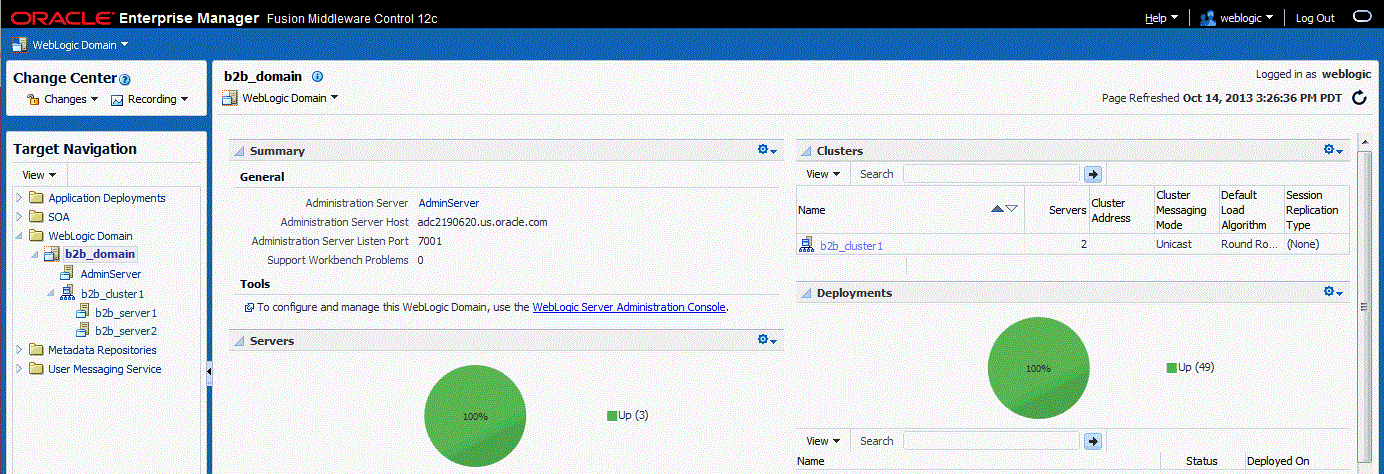
Description of the illustration config_b2b_servers_up.gif
3.4 Verifying Your Configuration
To verify that your domain is configured properly, see Section 5.1. You should familiarize yourself with the tasks described in the section and perform them to verify that your domain is properly configured.